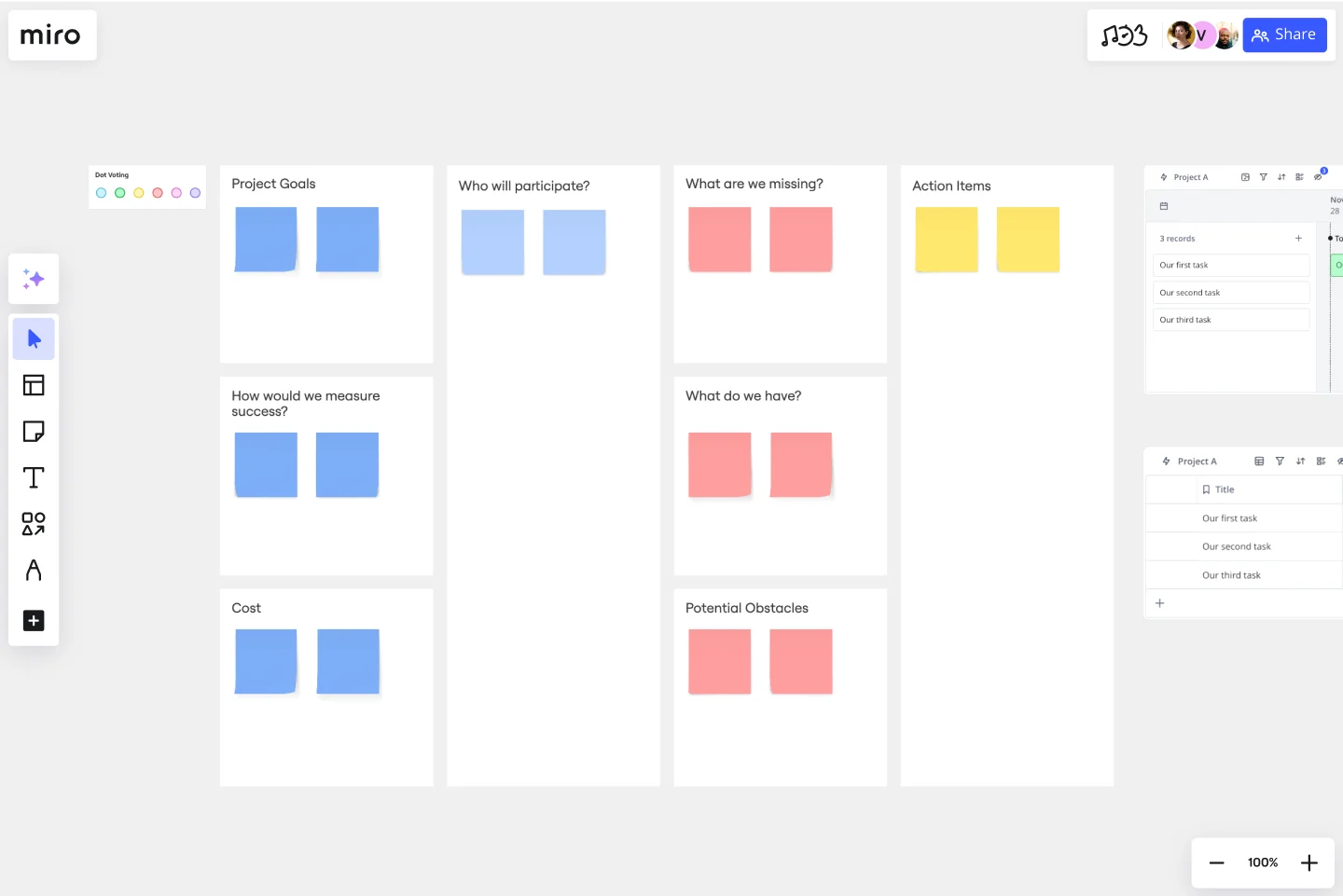Cost Benefit Analysis Templates
Miro's cost benefit templates help you evaluate decisions and analyze trade-offs effortlessly. Whether you're planning, budgeting, or problem-solving, these templates provide a clear structure to weigh costs, identify benefits, and make informed choices.
Project Planning Template
Works best for:
Project Management, Project Planning
A project plan is a single source of truth that helps teams visualize and reach project milestones. Project plans are most useful when you outline the project’s “what” and “why” to anyone who needs to give you project buy-in. Use a project plan to proactively discuss team needs; expectations; and baselines for timeline, budget, and scope. The plan will also help you clarify available resources before you kick off a project, as well as expected deliverables at the end of the project.
Cost-Benefit Analysis Template
Works best for:
Leadership, Decision Making, Strategic Planning
With so many day-to-day decisions to make—and each one feeling high-stakes—it’s easy for all the choices to weigh a business or organization down. You need a systematic way to analyze the risks and rewards. A cost benefit analysis gives you the clarity you need to make smart decisions. This template will let you conduct a CBA to help your team assess the pros and cons of new projects or business proposals—and ultimately help your company preserve your precious time, money, and social capital.
Monthly Budget Template
Works best for:
Project management, Planning
Miro's Monthly Budget Template is more than a budgeting tool; it's a step towards more strategic and efficient financial planning. Start today, and take control of your financial future, achieving your projects and goals.
Join thousands of teams collaborating and doing their best work on Miro.
Sign up freeAbout the Cost-Benefit Analysis Templates Collection
Our cost-benefit analysis templates help teams make informed decisions by weighing the costs and benefits of various options. These templates are perfect for people new to cost-benefit analysis and need a structured approach to evaluating their projects. With Miro's intuitive and visual planning tools, users can easily map out their analysis, ensuring that all factors are considered before making a decision.
Why you'll love our cost-benefit analysis templates
Using Miro's cost-benefit analysis templates offers many benefits:
Visual planning: Miro's templates allow you to visualize your analysis, making it easier to understand and communicate your findings to your team.
Structured approach: The templates provide a clear framework for conducting a cost-benefit analysis, ensuring
that no important details are overlooked.
Collaboration: Miro's collaborative features enable team members to work together in real time, adding their insights and feedback directly to the template.
Time-saving: By using a pre-designed template, you can save time on formatting and focus on the actual analysis.
Flexibility: The templates are customizable, allowing you to tailor them to your specific needs and preferences.
How to use the cost-benefit analysis templates in Miro
Define your objective: Clearly state the objective of your analysis. What decision are you trying to make? What options are you considering?
List costs and benefits: Use the template to list all the costs and benefits associated with each option. Be thorough and consider both direct and indirect factors.
Assign values: Assign monetary values to each cost and benefit. This step is crucial for quantifying the impact of each factor.
Analyze the sata: Use the template's built-in tools to analyze the data. Compare the total costs and benefits
for each option to determine which one offers the best value.
Collaborate and review: Share the template with your team and gather their input. Use Miro's collaboration features to discuss and refine your analysis.
Make a decision: Based on the analysis, make an informed decision. Document your findings and the rationale behind your choice in the template.
By following these steps, you can effectively use Miro's cost-benefit analysis templates to make well-informed decisions that drive your projects forward. These templates not only streamline the analysis process but also foster collaboration and ensure that all perspectives are considered, helping your team thrive.
